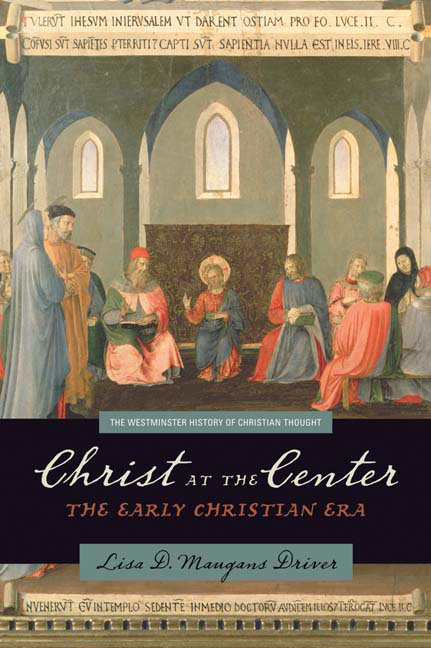Lisa Maugans Driver: Christ At The Center
 Lisa D. Maugans Driver, Christ At The Center: The Early Christian Era (Louisville: WJK, 2009), 242 pages, ISBN 9780664228972.
Lisa D. Maugans Driver, Christ At The Center: The Early Christian Era (Louisville: WJK, 2009), 242 pages, ISBN 9780664228972.
Driver offers the reader a fast-moving, panoramic view of the context and subsequent development of Christian doctrine as it progressed in the first five centuries of the Church. The work presents a wonderfully helpful, but brief sketch of the major events that formed such fundamental Christian beliefs as Christology, ecclesiology, and salvation. Driver’s intent was not to produce a comprehensive textbook on the history of early Christian doctrine, but rather a survey for those who wish to further explore the often detailed and complex world of the Early Church. She has succeeded in this task! This work offers the beginning student a wonderful resource for further study.
Driver sets the stage for the book by highlighting the anticipation experienced by the Jewish nation as they awaited their Messiah. She draws upon some of the historic events in the life of Israel like the Exodus, the division of Israel and Judah, the exile into captivity, and finally, the hope for restoration in order to demonstrate the Messianic hope. She further draws on the promise of salvation as given to the Jews through Abraham, which was renewed under Moses with the Law and Sinai. Thus, the postexilic and Second Temple Jews looked back to God’s promise, while looking ahead for its fulfillment. Yet, because of the political difficulties, i.e., being ruled by the successive kingdoms of Babylon, Persia, Greek and Hasmoneans, the Jews came to expect a political Messiah. However, she is clear that there was no unified Messianic expectation. There was simply a general desire to have God dwell among His people as was done in the Exodus, and for God to occupy His place as Ruler, which may or may not involve an actual human leader.
Driver then moves into the arrival of Jesus onto the scene and touches upon specific instances in His ministry that highlight His divine mission. However, great tension existed in that Jesus, for all intents and purposes, did not fit with the Jewish Messianic expectation. This was not limited to the general Jewish population but extended to Jesus’ own inner circle. Driver emphasizes Pauline writings that begin to unfold the proper understanding of how Jesus, the Christ, fits with the Jewish desire for salvation. She notes Paul’s general thesis in that in a very real way, there is no Israel without Jesus, the Christ. Further, the Pauline corpus finally brings into the focus the “right” perspective as to just how humanity is to view the salvific plan of God, i.e., weakness and foolishness become instruments of wisdom and power as evidenced in the cross.
For the Early Church, the arrival of Jesus Christ brought a new lens through which the whole created order must be viewed. Christians understood that in Christ, God’s plan for salvation involved the whole cosmos so that all of creation would undergo regeneration and transformation. This transformation included not only the physical world, but the spiritual as well. In this way, such natural phenomena like death took on a new meaning given by the One who was raised from the dead. Further, existing social structures such as communities and families were thought of in new terms as set forth by the traditions and teaching of the Church. Thus, morality, social responsibility, and the overall concern for others were rooted in a Christian’s identity in Christ. The entry point into this new community was at the baptismal font. Families would raise their children as Christians, and pagans would undergo an increasingly rigorous period of catechesis before entering the sacred baptismal waters. Being a part of the Christian community centered on the Eucharist, where the members of the Church could share in the partaking of the Body and Blood of their Lord.
Category: Fall 2011, Living the Faith, Pneuma Review


